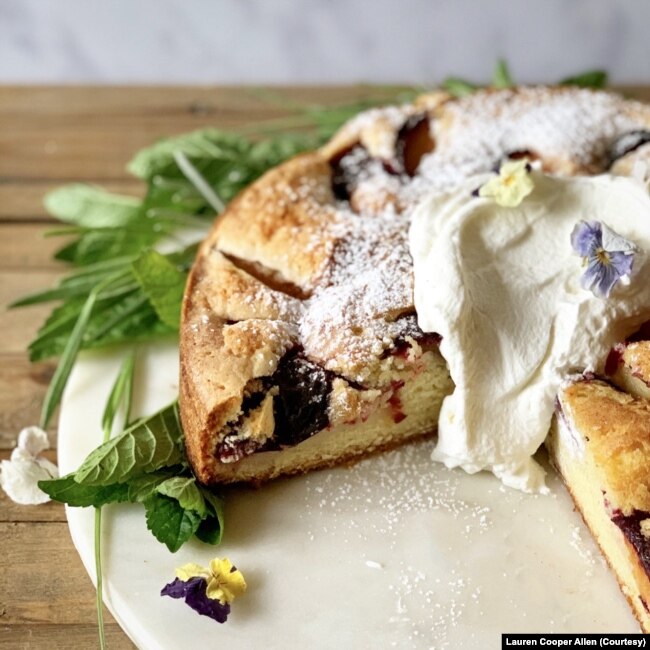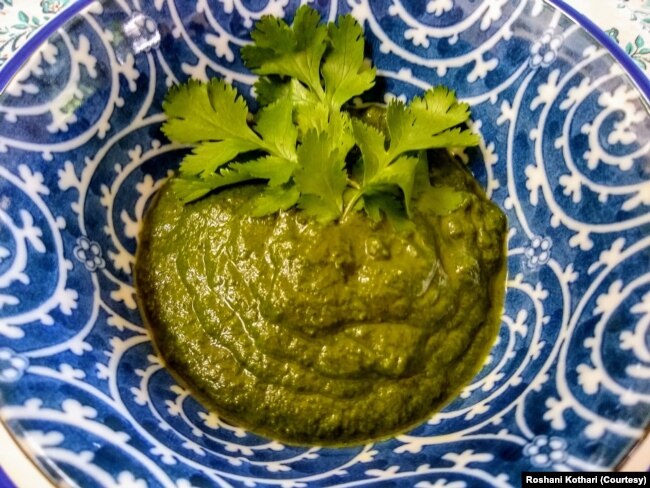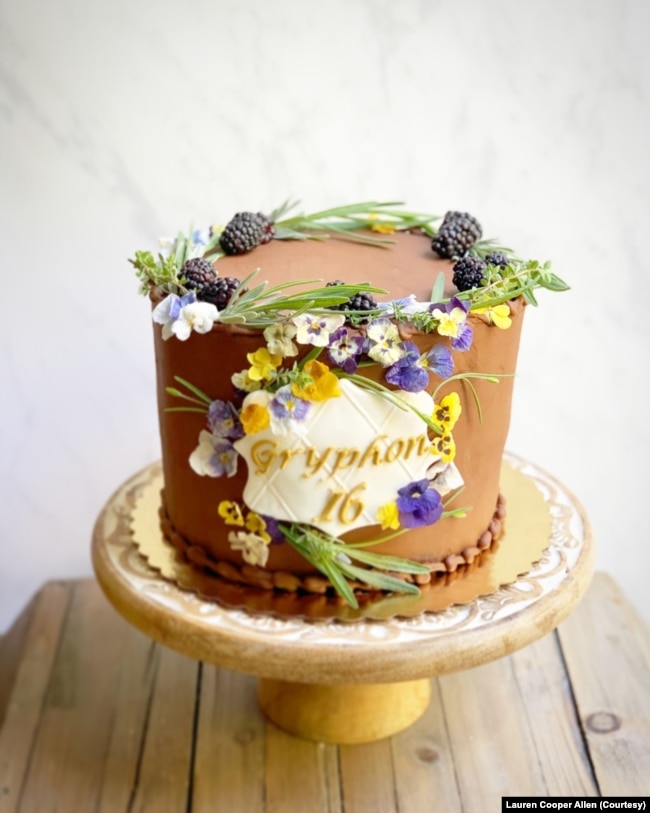花を食べよう♬
お部屋にいっぱいのお花。大好きです。
バラに紫陽花、ユリ、シャクヤク、牡丹。。。
でも今日のお花はちょっと違うんです!!
う~ん、おいしそう🎶
タンポポ、ナスタチウム、マリーゴールド、ボラージ、菫色、ラベンダー、ライラック、菊、カモミール、薔薇、胡蝶蘭、ハイビスカス。。。
色鮮やかな世界があなたをを待っていますよ!!!
食べられる花
Flowers You Can Eat
花は私たちの自然界の大切な存在です。その美しさと香りは、私たちを幸せにしてくれます。花は昆虫や鳥、動物の餌となります。そして、花は私たちの食べ物にもなります。
花の中には、食べ物や飲み物に彩りを添えたり、思いがけない味や美しさを与えてくれるものもあります。そして、食事に花を取り入れる人も増えています。もっと詳しく知るために、自分の花を育てて食べるのが好きなアメリカ人に話を聞いてみました。
キャシー・ジェンツさんはワシントン・ガーデナー誌の発行人。彼女はワシントンD.C.地域の園芸家に講演を行っていて、食用の花の育て方や使い方を教えてくれます。
準備
ジェンツさんは、次の料理や食事のためにほとんどの食用の花を準備する方法は、水で軽く洗うことだと言います。その後、花の白い部分を取り除きます。また、雌しべと雄しべを切り落とすことも大切だと言います。
食用の花について話すとき、ジェンツさんはしばしば3つのポイントから話を始めます。
1. 花を知ること。どの花が食べても安全なのか?
2. 花の産地を知る。その花はどこから来たのか?
3. 自分のアレルギーを知る。どの植物にアレルギーがあるのか?
 DC area baker, food stylist and photographer Lauren Cooper Allen uses edible flowers on her cakes and other baked creations. (Photo by Lauren Cooper Allen)
DC area baker, food stylist and photographer Lauren Cooper Allen uses edible flowers on her cakes and other baked creations. (Photo by Lauren Cooper Allen)
(DCエリアのパン屋、フードスタイリスト、写真家のローレン・クーパー・アレンさんは、ケーキや他の焼き菓子に食用の花を使用しています。)
花を知りましょう。
花の中には毒があり、病気になる可能性があるものもあります。毒のある花であっても、食用になると思われている花はいくつかあるのです、とジェンツさんは言います。
最も一般的なのはキンポウゲとスイートピーです。彼女によると、スイートピーの花は、野菜であるエンドウの花と混同してはいけないといいます。他にも、ツツジ、藤、キツネグサなどの毒花があります。
では、一般的な食用の花を簡単に挙げてみましょう。
ボラージ
菫色
ラベンダー
菊
薔薇
ハイビスカス
まずはどのエディブルフラワーから始めるのが良いの?タンポポ!?
食べられる花の中で、始めてみると良いものの一つにタンポポがあります。ジェンツさんによると、タンポポは栄養価が高く、花だけでなく植物全体を食べることができるそうです。これは多くの食用花には当てはまりません。
ナスタテチウムは栽培が簡単で、ジェンツさんによると、胡椒のような味がするとのこと。コンテナガーデニングや、暑くて大きな都市に住んでいる人には最適です。この花は、非常に難しい条件でもよく育つことが多いのです。
「本当にうまくいくコンテナ栽培の花はナスタチウムよ。実際、地面よりもコンテナ栽培を好むのよ。ナスタチウムに与えることができる最悪の条件 -- それですごくよく育つのよ。」
 Nasturtium is a commonly eaten flower. It grows well in difficult conditions. Washington, DC resident Elizabeth Lyttleton grows them in a pot on her porch step and uses them in dishes for her family. (Photo: Elizabeth Lyttleton)
Nasturtium is a commonly eaten flower. It grows well in difficult conditions. Washington, DC resident Elizabeth Lyttleton grows them in a pot on her porch step and uses them in dishes for her family. (Photo: Elizabeth Lyttleton)
(ナスタチウムはよく食べられる花です。難しい条件でもよく育ちます。ワシントンDC在住のエリザベス・レットルトンさんは、ポーチのステップ上のポットで育て、家族のために料理に使っています。)
多くの人がフルーツやグリーンサラダにナスタチウムを加えています。D.C.地域の母親であり、サイクリング活動家でもあるエリザベス・レットルトンさんもその一人です。暖かい気候では、玄関先でナスタチウムを育てると彼女は言います。その花をサラダに加えたり、他の料理に添えたりするのが好きなのです。
 Photographer and gardener Roshani Kothari mixes sage flowers with butter to put on top of bread. (Photo: Roshani Kothar
Photographer and gardener Roshani Kothari mixes sage flowers with butter to put on top of bread. (Photo: Roshani Kothar
(写真家で庭師のロシャニ・コタリさんは、セージの花をバターと混ぜてパンの上に乗せて。)
ハーブの花
また、D.C.エリアのロシャニ・コタリさんは、長年にわたり食用の花を育てて食べてきたと言います。彼女によると、ハーブは食用花の世界に入り込むのに最適な方法だと。ミント、ローズマリー、ディル、オレガノ、コリアンダー、セージなどの花は、ハーブの風味を少しだけ加えてくれます。しかし、それらは植物の葉ほど強くはありません。
コタリさんは、お気に入りのハーブのひとつがコリアンダーだといいます。
 DC area photographer, Roshani Kothari, grows her own flowers and uses them in her cooking. (Photo by Roshani Kothair)
DC area photographer, Roshani Kothari, grows her own flowers and uses them in her cooking. (Photo by Roshani Kothair)
(DCエリアの写真家、ロシャニ・コタリさんは、自分で花を育てて料理に使っています)
「そしてね、コリアンダーは鉢で育てるのが簡単なの。花を咲かせておけば、毎年花をつけてくれるの。そして、とっても多くの異なる文化で使われているのよ。例えば、私はもともとインドのグジャラート州出身ななんだけど、私たちが作る料理にはすべてコリアンダーを添え物として使うの。コリアンダーがないと、まだ......まだ完成していないのよ!」
花の産地を知ろう
専門家によると、食用の花を食べるには自分で育てるのが一番安全だそうです。ファーマーズマーケットや農家から購入する場合は、化学薬品を使用していないかどうかを直接聞いてみましょう。食品店や花屋から買う場合は注意が必要です。その花には危険な化学薬品が使われているかもしれません。
食用の花を摘みに屋外に出かける場合は、安全な場所で行うようにしましょう、とキャシー・ジェンツさん。犬の散歩をさせている場所や、化学処理された場所から花を採取しないでください。
花の産地を知ろう
専門家によると、食用の花を食べるには自分で育てるのが一番安全だそうです。ファーマーズマーケットや農家から購入する場合は、化学薬品を使用していないかどうかを直接聞いてみましょう。食品店や花屋から買う場合は注意が必要です。その花には危険な化学薬品が使われているかもしれません。
キャシー・ジェンツ氏によると、食用の花を摘みに屋外に出かける場合は、安全な場所で行うようにしましょう。花が咲いている場所から花を採取しないようにしましょう。
ボラージ
ジェンツさんは、個人的に好きな食用の花はボラージだと言います。彼女によると、この植物の青い星型の花はキュウリのような味がするそうです。だから、ボラージはいろんな料理に合うのです。
「個人的なお気に入りはボラージよ。花びらはきゅうりのような香りと味がするの。フルーツサラダに加えたり、ガスパチョに入れたり、飲み物のアクセントに使ったりできるのは嬉しい特典だわ。」
 Baker, food stylist and photographer Lauren Cooper Allen uses edible flowers, such as violets, on her cakes and other baked treats. In this photo, she used pansies on a birthday cake.(Photo by Lauren Cooper Allen)
Baker, food stylist and photographer Lauren Cooper Allen uses edible flowers, such as violets, on her cakes and other baked treats. In this photo, she used pansies on a birthday cake.(Photo by Lauren Cooper Allen)
(ベイカー、フードスタイリスト、フォトグラファーのローレン・クーパー・アレンは、スミレなどの食用花をケーキや他の焼き菓子に使っています。この写真では、彼女は誕生日ケーキにパンジーを使っています)
スミレ
スミレも人気のある食用花です。甘い香りがします。スミレは、サラダや甘いお菓子、飲み物などに使いましょう。
また、スミレは密閉容器に入れて冷蔵庫に入れておくと日持ちがするとジェンツさんは言います。しかし、適切なタイミングで花をカットすることが重要であると言います - それはちょうど花開くそのタイミング。
これはすべての食用の花に当てはまるわけではありません。いくつかは非常に速くしおれてしまいます。これを避けるために、ジェンツさんは、人々が何世紀にもわたってしている方法を使用することができると言います - 乾燥させるのです。
野菜の花
植物がどのように成長するかを知ることが大切だとコタリさんは説明しています。野菜は種子をつけさせれば食べられる花をつけます。
でも、野菜の植物から花をすべて取ってしまったら、野菜は収穫出来ない、と専門家は注意を促します。野菜の花を収穫したいのであれば、花のために野菜の植物を育てることをジェンツさんは提案しています。
カモミールの花は小さく、リンゴのような味がします。カモミールは紅茶によく使われます。ジェンツさんは、カモミールの花はきれいに乾燥させると、味を保つことができると言います。
ただし、WebMD のウェブサイトは、カモミール”これらの植物にアレルギーがある場合は避けるように警告しています: ラグウィード、ヒナギク、マリーゴールド、または菊”
自身のアレルギーを知ろう
ブタクサや他の種類の花粉にアレルギーがある場合、ジェンツさんはヒナギク科の花を避けることを勧めています。
また、アレルギーや他の食物過敏症をお持ちの方は、新しい食用の花を一度に一つずつ試してみるようにと。最初にたくさんの花を食べて病気になってしまうと、どれが原因で病気になったのかわからなくなってしまうからです。
ジェンツさんはまた、次のように注意をうながしています。4歳未満の子供には食用花を与えないでと。
ちょっと寄り道
英語の小窓:the more(比較級)、the more(比較級)
ご存じの通り「~すればするほど」ですね。
The sooner, the better.
早ければ早いほどよい。
S V がついて
「the more(比較級)+ 主語 + 動詞、the more(比較級)+ 主語 + 動詞」
The more I know her, the more I love her.
知れば知るほどます彼女が好きになる。
The kinder you are to him, the happier he will be.
君が彼に優しくすればするほど、彼はしあわせだろう。
ここで出てきたした下の文章みて、学生時代の構文を思い出しました。
The worst conditions you can give nasturtium -- the better it grows.
The worse the condition is ,the better it grows
原文 Flowers You Can Eat
 Sage flowers are just one of the many edible flowers photographer and gardener, Roshani Kothari, uses in her cooking. (Photo by Roshani Kothair)
Sage flowers are just one of the many edible flowers photographer and gardener, Roshani Kothari, uses in her cooking. (Photo by Roshani Kothair)
Flowers are an important part of our natural world. Their beauty and smell can make us happy. Flowers serve as food for insects, birds, and animals. And they can also feed us!
Some flowers add color, unexpected taste, and beauty to food and drinks. And more people are adding them to their meals. To find out more, we talked with a few Americans who like to grow and eat their own flowers.
Kathy Jentz is the publisher of Washington Gardener magazine. She also gives talks to Washington, D.C. area gardeners. She tells them how to grow and use edible flowers.
Preparation
Jentz says the way to prepare most edible flowers for your next dish or meal is to wash them lightly under water. Then remove the white parts of the flower. She also says to cut off the pistil and stamen.
When speaking about edible flowers, Jentz often begins with three talking points:
- Know your flowers. Which ones are safe to eat?
- Know the source. Where did the flowers come from?
- Know your allergies. Which plants are you allergic to?
Know your flowers.
Some flowers are poisonous and can make you sick. There are a few flowers that people think are edible, Jentz says, even though they are poisonous.
The most common are buttercup and sweet pea. She says the flower of the sweet pea should not be mixed up with the flower of the pea plant, which is a vegetable. Other poisonous flowers are azalea, wisteria, and fox glove.
Now, here is a quick list of common edible flowers.
One of the best edible flowers to start with is the dandelion. Jentz says they are nutritious, and you can eat the entire plant, not just the flower. This is not true for many edible flowers.
Nasturtium
Nasturtium is easy to grow and, Jentz says, has a peppery taste. It is perfect for container gardening and for people living in a hot, big city. This flower often grows well in very difficult conditions.
“A container-grown flower that works really is nasturtium. It actually prefers container growing to being in the ground. The worst conditions you can give nasturtium -- the better it grows.”
Many people add nasturtium to fruit or green salads. One such person is Elizabeth Lyttleton, a mother and cycling activist in the D.C. area. In warm weather, Lyttleton says she grows nasturtium on her front doorstep. She likes to add its flowers to salads or serve with other foods.
Herb flowers
Also, in the D.C. area, Roshani Kothari says she has been growing and eating edible flowers for many years. She says that herbs are great ways to get into the world of edible flowers. Flowers from mint, rosemary, dill, oregano, cilantro, and sage add a little flavor of the herb. But they are not as strong as the leaves of the plant.
Kothari says one of her favorite herbs is cilantro.
“And cilantro is easy to grow in a pot. If you let it go to flower, it will come back year after year. And um, it’s used in so many different cultures. For example, I’m from India originally from the state of Gujarat and we use cilantro as a garnish in all the dishes we make. Without cilantro it’s not quite … quite done yet!”
Know the source of the flowers
Experts say the safest way to eat edible flowers is to grow them yourself. If you buy from a farmer’s market or a farmer, ask them directly if they used any chemicals. Be careful buying from a food or flower store. Their flowers may have been treated with dangerous chemicals.
If you go outdoors to pick edible flowers, says Kathy Jentz, do so in a safe area. Do not collect flowers from an area where dog owners walk their dogs or where chemical treatments have been used.
Borage
Jentz says her personal favorite edible flower is borage. She says the plant’s blue star-shaped flowers taste like cucumbers. So, borage can go with many dishes.
“My personal favorite is borage. The flower petals smell and taste like cucumber. The fact that you can add it on fruit salads, throw it in your gazpacho or use it to garnish a drink is a nice bonus.”
Violets
Violets are another popular edible flower. They have a sweet flavor. Use the violets in salads, sweet treats, and drinks.
Also, Jentz says violets can last a long time when left in a sealed container in the refrigerator. But she adds it is important to cut the flowers at the right time -- just as they open.
This is not true of all edible flowers. Some wilt quite fast. To avoid this, Jentz says you can use the method people have been using for centuries – dry them.
Vegetable flowers
Kothari explains that it is important to know how plants grow. Vegetables send out edible flowers if you let them go to seed.
However, if you take all the flowers from your vegetable plants, our experts warn, you will not have any vegetables! If you want to harvest the flowers of vegetables, Jentz suggests growing a vegetable plant just for its flowers.
Chamomile
Chamomile flowers are small and taste like apple. Chamomile is often used in tea. Jentz says chamomile flowers dry nicely and they keep their flavor.
However, the website WebMD warns avoid chamomile “if you are allergic to these plants: ragweed, daisies, marigolds, or chrysanthemums.
Know your own allergies
If you have allergies to ragweed and other types of pollen, Jentz advises to avoid any flower in the daisy family.
Also, if you suffer from allergies or have other food sensitivities, Jentz suggests trying new edible flowers one at a time. If you eat many different ones for the first time and then get sick, you will not know which one made you sick.
Jentz also gives this warning: Do not give edible flowers to any child under the age of four.
________________________________________________________________
Words in This Story
pistil – n. the part in the center of a flower that is made up of the stigma, style, and ovary and produces the seed
stamen – n. the part of a flower that produces pollen and is made up of an anther and a filament
allergy – n. a medical condition that causes someone to become sick after eating, touching, or breathing something that is harmless to most people allergic – adj.
peppery – adj. having a lively, aggressive, or somewhat shocking quality
herb – n. a plant or a part of a plant that is used as medicine or to give flavor to food
garnish – n. something (such as lemon wedges or parsley) used
to decorate or flavor food or drink
petal – n. one of the soft, colorful parts of a flower
refrigerator – n. a device or room that is used to keep things (such as food and drinks) cold
wilt – v. of a plant : to bend over because of not having enough water